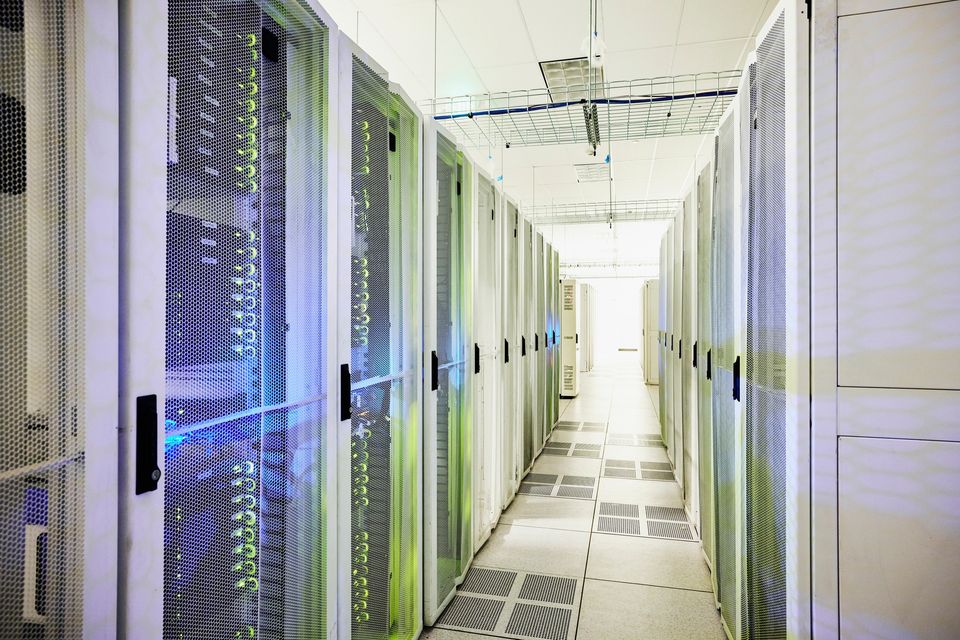
University of Hawaii celebrates supercomputer milestone
By Ryan Kawalani Ozawa
Mana has 8,500 computing cores, 120 GPUs, more than 63 terabytes of RAM, and more than 1 million gigabytes of storage.
Although a relatively small public institution, the University of Hawaii has played an outsized role in dozens of disciplines, including technology.
Last summer, UH marked the 50th anniversary of ALOHAnet, which formed part the foundation of all wireless communications today, including mobile, satellite, cellular and WiFi. The technology is internationally recognized as one of the critical enabling technologies for the internet before it was called the internet.
Yesterday, UH hosted a High Performance Computing Symposium to mark the seventh anniversary of its Mana high-performance computing cluster, a powerful resource that’s shared with the broader research and technological community.
Thirty years of history
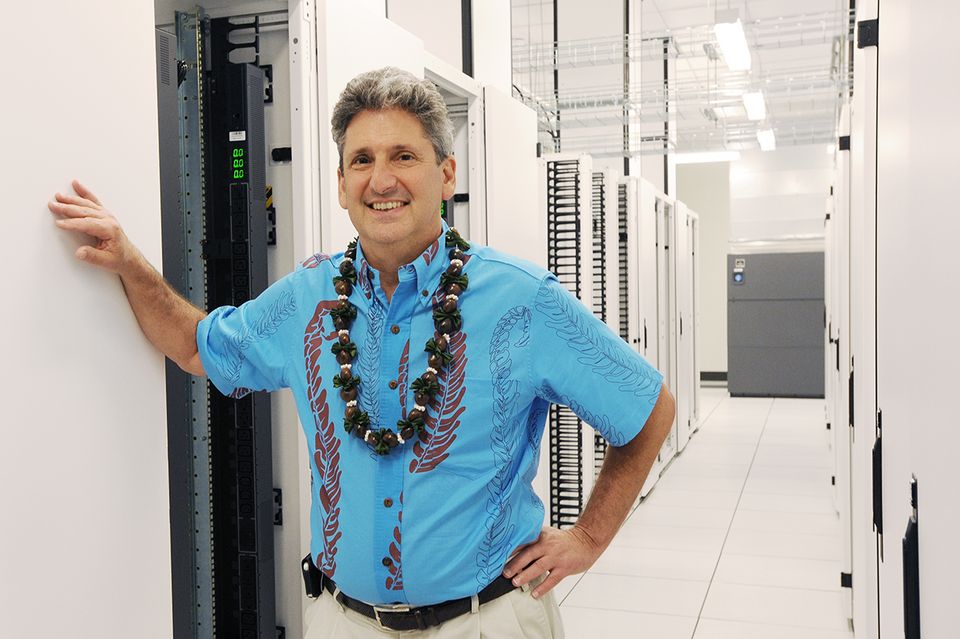
Today, the UH Manoa campus is home to a 74,000-square-foot Information Technology Center, which houses essential IT services for both the UH system as well as the state of Hawaii. This includes a disaster-hardened 8,000-square-foot data center.
But in 1989, when UH President David Lassner was named the first interim director of IT, the infrastructure he was tasked with managing was a sprawling mess.
“At the time technology was managed by four different operating units that reported to three different VPs,” Lassner said. “Most research units bought and operated their own hardware — mini computers, mostly, although we were starting to see workstations.”
Indeed, the university touted its distributed computing resources as a plus, proclaiming in 1992 that “research computing is flourishing at UH,” with about 300 workstations on the Manoa campus.
“The overall computing capacity this represents dwarfs the total power of centralized systems available in the university,” the first strategic plan said.
It was slow going at first.
“The university had made little progress in moving seriously into the computing areas attracting the most attention in research at the time, high performance parallel processing and data visualization,” Lassner said.
In 1994, UH got a new president, Kenneth Mortimer, who came to Lassner with the most recent IT strategic plan. Lassner recalls: “He said, ‘I hate to see plans that nobody acts on, what do we have to do?'”
Soon enough, Mortimer assigned all IT to one senior vice president, Ralph Horii, who asked Lassner to be the Chief Information Officer. At one of their first meetings, Horii showed Lassner a picture of Brown University’s new IT center on the cover of a magazine.
“He told me to start planning something,” Lassner said. “Little did I know how long that would take.”
UH Information Technology Services was created that year, as was another IT strategic plan, this one looking forward to high-speed internet access and high-performance computing — something that had always been a priority, but had proved elusive.
Although UH was the first institution to join the San Diego Supercomputing Consortium in the 1990s, for example, it struggled to compete for resources and was constrained by limited bandwidth between Hawaii and the mainland.
In 2001, UH beat out the University of New Mexico in a bid to operate the Maui High Performance Computing Center (MHPCC), which it still manages today. But again, access to its computing resources were restricted, largely due to Department of Defense security requirements.
In fact, Lassner said, as computer workstations became common, prevailing wisdom started to turn against centralized computing, questioning whether every university should have its own super computer.
Lassner and ITS made the most of their existing hub in Keller Hall.
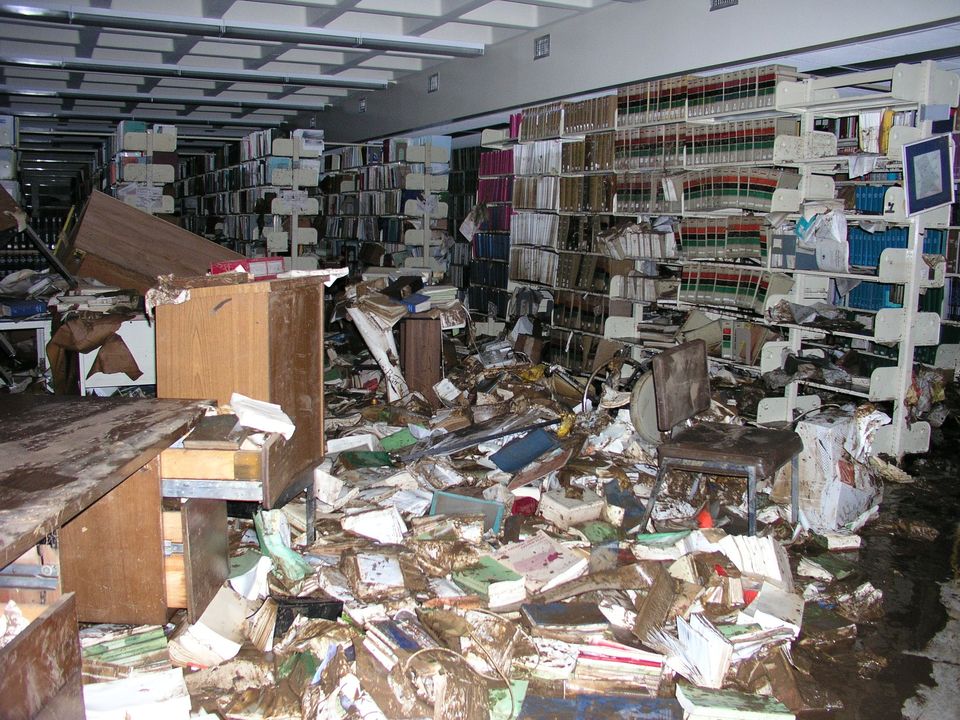
“Then, in 2004, the big flood, on Halloween, came,” he recalled. “Water came close to Keller Hall and dangerously close to our machine room.”
Funding came through in 2008 to design a new IT center, and construction funds were allocated in 2011. Groundbreaking took place the following year, and it was dedicated in 2013.
“I never got to move in,” Lassner said, as he’d been appointed interim president of the University that year, and officially got the job the following summer.
But the IT Center is clearly something Lassner is proud of.
“In my letter of appointment as president, I have no payout, I have no job when I’m done being president,” he said. “But what I asked for, and the Board of Regents gave me, was the non-compensated title of president emeritus and an office in the IT center… far out of the hair of any future president.”
Supercomputing surges in Manoa
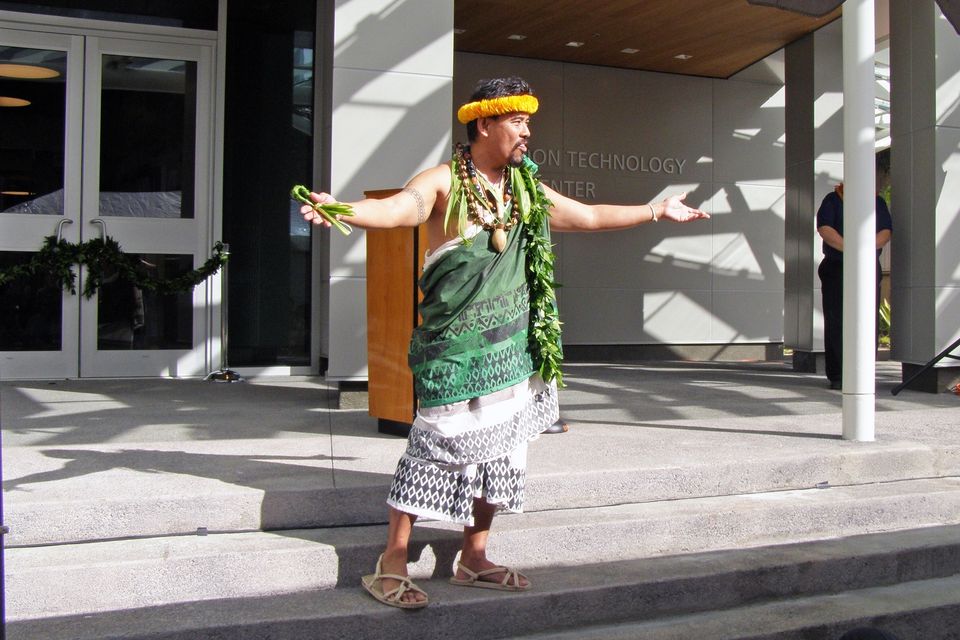
As the new IT Center was coming on line, Dr. Gwen Jacobs was brought on board as the first Director of Cyberinfrastructure.
Jacobs had made waves at Montana State University with the Lariat Networking Project, a $10 million initiative to upgrade IT infrastructure at six western U.S. institutions, and she came to Hawaii on sabbatical. She never left, taking on the task of building up research computing at UH.
“It’s been a long journey to build cyberinfrastructure here,” Jacobs said.
“Back in 2014, David worked his magic and we were able to get $1.8 million to actually buy our very first super computer, the Cray,” Jacobs recalled. “We opened for business with seven early adopters in 2015.”
Key to the long-term success of the UH supercomputer was a “condo model,” where researchers could co-locate and share computing resources.
“In 2016 we received another $733,000 in [principal investigator] investment,” she said. “These are folks that are buying their own nodes and contributing to the growth and maintenance of the cluster.”
A critical upgrade came in 2020, with a $700,000 National Science Foundation grant to add GPUs (graphics processing units), which addressed newer scientific fields like machine learning and artificial intelligence.
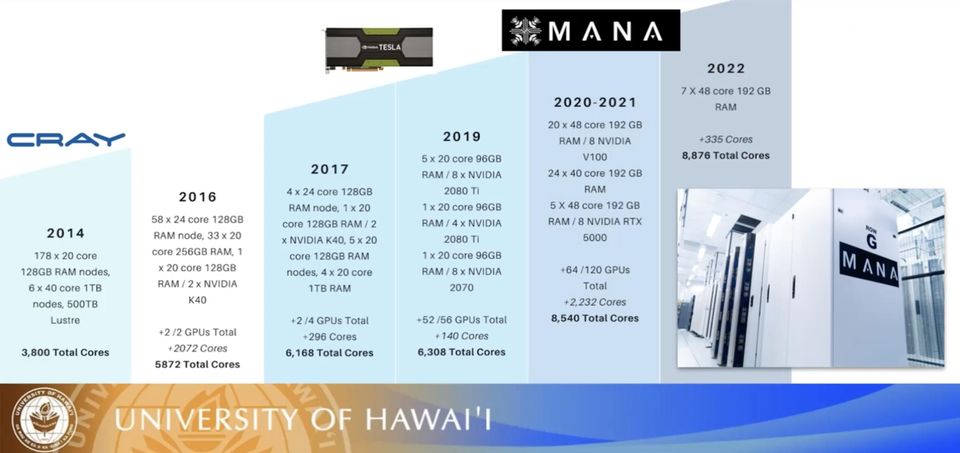
As of today, $4.5 million has been invested in the high-performance computer cluster. Jacobs said the next big investment will be in large-scale storage systems.
At a Glance:
2014: 3,800 cores, 0 GPUs, 7 users.
2022: 8,964 cores, 120 GPUs, 353 users (726 historically).
Serves six campuses on three islands.
Used in 90 disciplines to generate 130 research papers.
“One time money is great, but the secret sauce is to be able to have a sustainable financial model on a going forward to make sure that these resources don’t simply age out in place and become a space heater,” said Garrett Yoshimi, UH VP for Information Technology and Chief Information Officer.
One key aspect of the UH high-performance computing cluster is that it is made available for free to a broad cross section of the university community.
“We systemically use the free clusters and free cycles to deliver services to researchers, especially the folks starting up in the field as well as to our students, to be able to make use of this class of resource that they would otherwise not be able to buy into.
“They can use the resource, get up to speed on it, then write their own grant proposals and program proposals to be able to grow their research as well as help us sustain our cluster,” he added.
Diverse applications
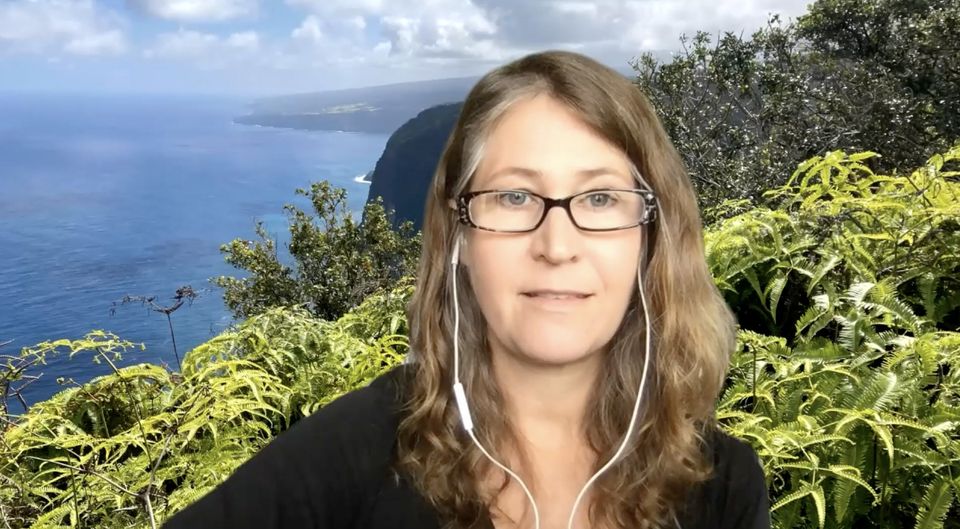
Jacobs notes that the supercomputer, dubbed Mana, is being used for work in a wide variety of disciplines. In addition to math, computer science and engineering, the supercomputer is used for biology, ocean and atmospheric science, physics, astrophysics, chemistry, and even social science.
As part of the symposium, a number of researchers presented “lightning talks” on the work they were doing with Mana.
“I moved to Hawaii in 2015 a a postdoc, and none of my progress would have been possible were it not for MANA,” said Renee Bellinger of UH Hilo. “All of my projects have relied on MANA and the exceptional UH cyberinfrastructure team.”
Bellinger specializes in conservation genomics of endemic Hawaiian species. And she notes that the evolution of the field of genomics has paralleled the evolution of computational power. To date, scientists have mapped 8,000 animal genomes, and 2,000 plant genomes.

“What makes Hawaii extra interesting in terms of genome sequening projects is that Hawaii is very remote, so when there is a founding event by an animal or plant, it was an infrequent event,” she explained. “They encountered these novel habitats and novel ecological communities, and as a result, these animals and plants evolved thexe extraordinaril diverse forms.
“You might have for example one bird species that made it all the way over to the Hawaiian islands, and then diversified into over 70 distinct forms or species,” she added.
She said her two genome sequencing projects were only possible thanks to Mana, including sequencing the genome of the ʻalalā (Corvus hawaiiensis), or Hawaiian crow. It’s endemic to Hawaii, extinct in the wild, with only 110 known living birds.
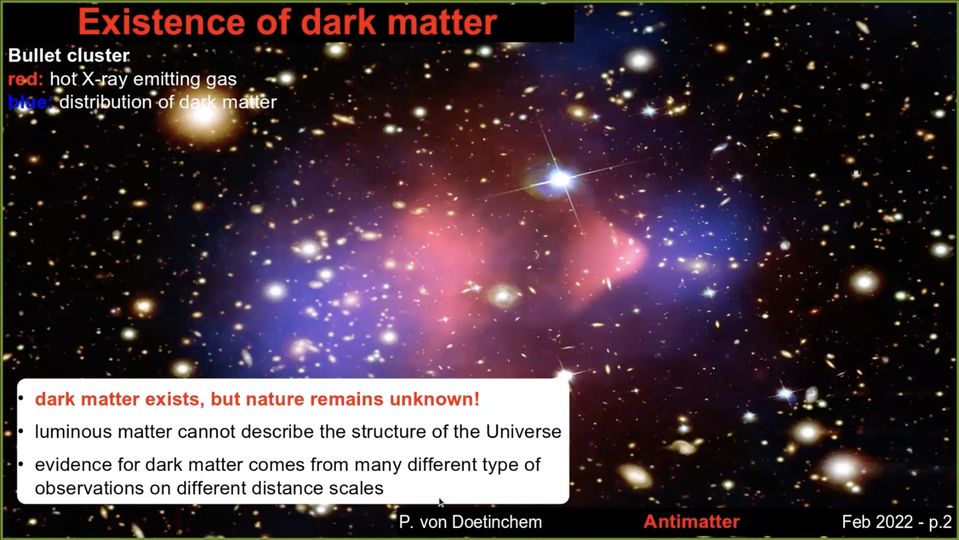
Mana is also critical to the work of Philip von Doetinchem, an associate professor of physics and astronomy. His research focuses on dark matter, which is known to exist but is impossible to directly observe.
One way to assess the presence of dark matter, he says, is through antimatter. But antimatter often needs to be computer simulated, which takes thousands of hours of computer time.
“For example, antihelium is extremely rare, extremely hard to produce, so we really needed this computing power,” von Doetinchem said. “Nobody had ever done this before, some people told us, ‘You can’t do this, you need way too much computing power,’ but we made it possible.”
And the work done with Mana, he says, are used by partner institutions like MIT, Columbia University, Berkeley, the Italian Institute of Nuclear Physics and the Japan Space Agency.
“Mana enables cutting edge, world class research of far reaching relevance,” he said. “What we do here is not only benefiting our local group here, but also particle physics is very national and international.”

Peter Sadowski, a UH assistant professor who works with the AI Precision Health Institute at the UH Cancer Center, said his work relies on supercomputers.
“To build AI (artificial intelligence) you need learning from data, and the latest machine learning techniques all make very heavy use of high-performance computing — you need tons of data and GPUs,” he said. “It’s impossible to do AI research without GPUs, and Mana is this great resource that makes my research possible and a great research tool for students who can access GPUs for free.”
Sadowski said supercomputers are used in developing computer vision, speech recognition, natural language processing, weather forecasting, and medical diagnosis.
Example applications Sadowski presented included automated data analysis to track the movements of fish in hours of biology lab video, forecasting tropical cyclones, or predicting mortality from full-body X-ray images.
“One of the great things about Hawaii is that we have all this unique access to special data, from astronomy, geosciences, oceanography, ecology and a very diverse population for the health sciences,” he said. “Hawaii really is a playground for data science.”
